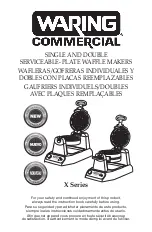
56
GB
Troubleshooting:
a) Measure the ingredients properly.
b) Modify dosing of ingredients and check if you added all ingredients to dough.
c) Use other liquid or let it cool to room temperature.
d) Add the ingredients required by recipe in correct order. Create a shallow hole in the
centre of flour and put yeast or dried yeast to it. Avoid direct contact of yeast with liquid.
e) Use fresh and properly stored ingredients.
f) Reduce total quantity of ingredients; in no case use more flour than specified.
Alternatively, reduce quantity of all ingredients by 1/3.
g) Modify amount of liquid. If ingredients used contain water, water added must be
decreased appropriately.
h) In case of humid weather, reduce water content by 1 - 2 tablespoons.
i) When hot, do not use the delayed start function. Use cold liquids. To shorten rising time,
select the
4-RYCHLÝ (QUICK)
or program
7-SUPER RYCHLÝ (SUPER FAST)
.
j) Remove bread from the pan immediately after baking and let it cool down before slicing
for at least 15 minutes on a suitable pad (e.g. cutting board).
k) Use less yeast or reduce quantity of all ingredients by 1/4 of amount specified.
XII. NOTICES TO RECIPES
1. Ingredients
Measuring as well as the order in which the ingredients are added are similarly important
because each ingredient plays a specific role for successful baking of bread.
–
The most important ingredients such as liquids, flour, salt, sugar and yeast (either
standard or dried) influence successful result of dough and bread result. Always use the
right quantity at proper ratio.
–
Use warm ingredients if dough has to be prepared immediately. If you wish to use the
delayed start function, we recommend using of cold ingredients to prevent premature
rising of yeast.
–
Margarine, butter and milk influence taste and smell of the bread.
–
To have crust lighter and thinner, you can reduce sugar content by 20 % without effect of
successful baking result. Replace sugar with honey if you prefer softer and lighter crust.
–
If you want to add cereals, let them soak over night. Reduce flour and liquid content (up
to 1/5). Yeast is absolutely necessary for rye flour.
–
If you want to have especially light bread, rich to ingredients supporting bowel activity,
add wheat bran to dough. Dosing is one tablespoon per 500 g of flour and increase
liquid amount by one tablespoon.
–
Fermentation is necessary for rye flour. It contains bacteria of lactic acid and acetic acid
and they cause the bread is light and finely acid. You can produce the ferment, however
you must take into account time required for its production. Therefore, our recipes use
powdered ferment, a concentrate that can be purchased in a 15 g sack (per one kg of
flour). Keep proportions in the recipe to avoid splitting of the bread. If you use powdered
ferment in a different concentration (a 100 g sack per 1 kg of flour), you must reduce
amount of flour: 1 kg by about 80 g or adjust the recipe accordingly.
















































